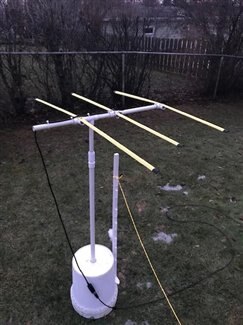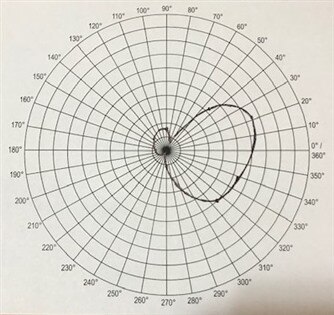 | Enter Your Project for a chance to win a Spectrum Analyzer for the Most Innovative RF Project! | Project14 Home |
| Monthly Themes | ||
| Monthly Theme Poll |
Phase 2 of testing antenna radiation patterns. The intro to this journey is Antenna Radiation.
Phase 2 will be to test a 3-element Yagi. After measuring the 8 compass points (N, NE, E, SE, S, SW, W, NW), I will try to verify the shape of the forward lobe.
The original Yagi planned for this segment was a three-element one built into a re-purposed hockey stick. But... that one was built for Radio Direction Finding and didn't have a means to mount it. Once again, I had to move to Plan B - a tape measure Yagi. I'm pretty sure that this one does not radiate directly off the end. Moving forward, I will use the measurements to see if I can steer the beam more in line with what it should be,.
Preliminary testing of the tape measure Yagi showed enough promise to proceed but it does suffer from droopy elements and is very susceptible to wind moving the elements during testing. As with the dipole test, the white stake under the radiating element is to insure that I make readings at the same distance from the feed point.
The graphic above is from Yagi-Uda.com and shows the operating characteristics of the three element "beam" antenna.
As we used to say in the Army... No plan ever survives contact with the enemy. In one series of measurements, the main lobe cants left and a definite null shows in the rear right. In another series, the main lobe cants right and there is a definite null in the rear left. I will probably have to modify my tape measure Yagi to get repeatable measurements.
I have added PVC supports beneath each of the tape measure elements. So much for being able to fold the elements for easy storage. I videotaped another series of measurements. This series somewhat agreed with the series from the day before. It still doesn't seem correct.
I had also taken a series of panoramic videos. Using my measuring string and starting in the rear, I circled the antenna in a counterclockwise direction recording the meter output. I reviewed those. These resulted in something more like what I was expecting.
The rear lobes in the panoramic readings would be obscured by the center of the graph. I attribute the low readings to having to overcome the P-N junction voltage of the Germanium diodes in the detector circuit of the meter. When measured at 1 meter instead of two, the lobes are present but no where as clearly defined as the Yagi-Uda graphic above. At one meter, the rear lobe measured approximately 135mV. The front lobe at the same distance was 2100mV.
The red arrow indicates the approximate center of the forward lobe and indicates less than bilateral symmetry. Based on using this antenna for radio direction finding, this is correct. I expected the skew to be greater, but that was probably corrected when I added the PVC support to the elements.
Testing the Yagi antenna proved to be challenging. The originally flexible elements were most likely the culprits. One cannot watch the meter AND the elements at the same time.
The second objective of this phase was to verify the shape of the forward lobe. This exercise was underwhelming. Step back slightly until the field strength meter reads approximately 200mV. Drop a popsicle stick. Yup. It's an arc.
What was cool was seeing antenna polarization (orientation) in action. It wasn't until the last series of measurements that it dawned on me to orient the field strength meter horizontally - since the Yagi is horizontally polarized as I have it mounted. Readings that were in the 400mV range jumped up a full volt. I had read that the wrong polarization results in a 20dB reduction. During radio direction finding exercises (fox hunts), you want the attenuation to help localize the hidden transmitter. I now have a means to demonstrate this concept to new radio amateurs.
Once the weather turns a bit nicer, I will try to trim the Yagi to get rid of the skew. I will do this by measuring the RF power levels at 45 degrees right and 45 degrees left of center. When they are as close as practical to one another, I will know that my forward lobe actually points forward.
Phase 3 will be to test an antenna with a cardioid radiation pattern. Antenna Radiation - Phase 3






Top Comments
-

14rhb
-
Cancel
-
Vote Up
+4
Vote Down
-
-
Sign in to reply
-
More
-
Cancel
-

kmikemoo
in reply to 14rhb
-
Cancel
-
Vote Up
+2
Vote Down
-
-
Sign in to reply
-
More
-
Cancel
-

14rhb
in reply to kmikemoo
-
Cancel
-
Vote Up
0
Vote Down
-
-
Sign in to reply
-
More
-
Cancel
Comment-

14rhb
in reply to kmikemoo
-
Cancel
-
Vote Up
0
Vote Down
-
-
Sign in to reply
-
More
-
Cancel
Children